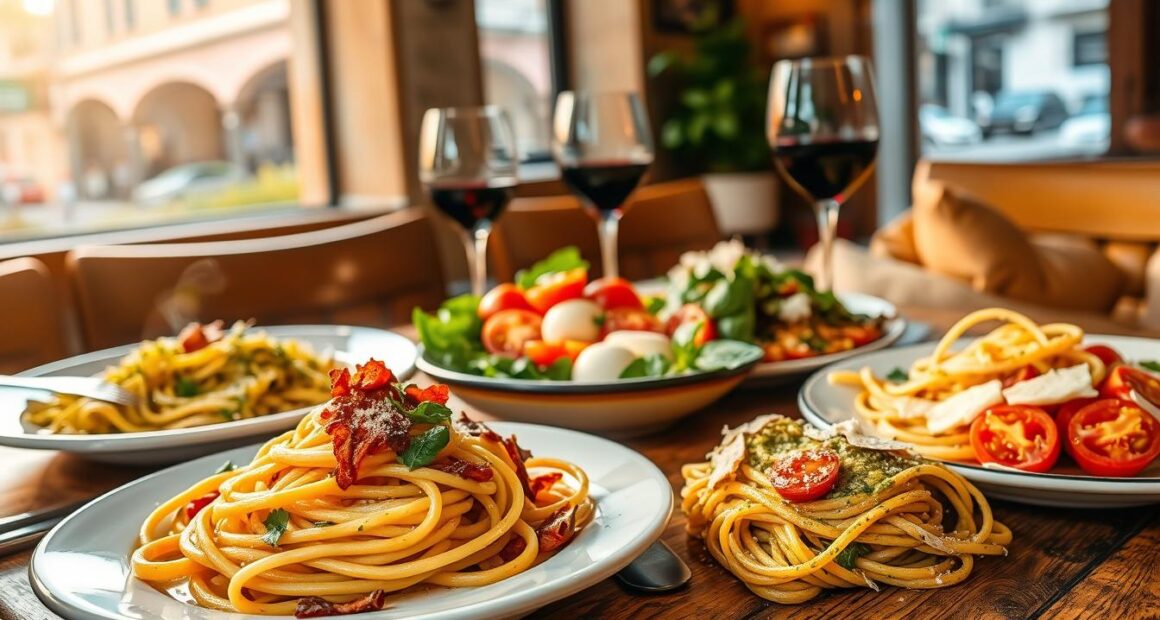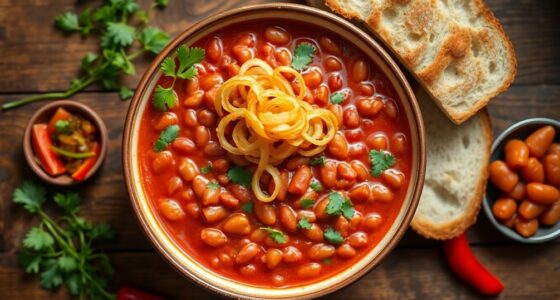Italian cuisine holds a special place in the hearts of many, evoking memories of gatherings around a table laden with dishes that are as colorful as they are flavorful. From the first bite of wood-fired pizza to the comforting taste of homemade pasta, each dish tells a story rooted in tradition and passion. Remember the aroma of fresh basil mingling with ripe tomatoes in your aunt’s kitchen or the laughter shared over plates of rich lasagna at family reunions? Every experience invites you to indulge in the essence of authentic Italian food, inviting you to savor not only the meal but the memories it creates as well. With countless flavors to explore and a rich heritage behind every dish, let’s dive into the vibrant world of Italian cuisine, where every meal is a celebration of life.
Italy is renowned for its culinary heritage, with 35 traditional dishes highlighted as essential to experience. The diversity of its regions welcomes you to discover classic favorites like ragu alla Bolognese, which has made its way into global kitchens often as spaghetti bolognaise, or orecchiette alle Cime di Rapa, originating from Puglia. Each plate carries a piece of Italy’s rich tapestry, ensuring that wherever you dine, especially at the best Italian restaurants, you partake in a delicious culinary journey.
Key Takeaways
- Italian cuisine reflects a rich tapestry of regional dishes and traditional recipes.
- Authentic Italian food is celebrated for its vibrant flavors and fresh ingredients.
- Signature dishes like ragu alla Bolognese and pizza Margherita are must-tries.
- Italian culinary traditions emphasize the importance of family and community.
- Exploring local variations enhances your appreciation for Italian culture.
What is Italian Cuisine?
Italian cuisine is much more than just food; it reflects a comprehensive expression of cultural identity and rich regional traditions. It encompasses an array of flavors, ingredients, and cooking techniques that vary from one region to another. Traditional Italian dishes are a testament to this diversity, showcasing unique characteristics influenced by local resources and culinary history. Whether you’re indulging in a handmade pasta or savoring a slice of authentic pizza, the joy found in this cuisine is truly remarkable.
Key Ingredients in Italian Cooking
At the heart of Italian cooking are essential ingredients that define the flavors of this beloved cuisine. Olive oil is a staple, serving as a base for dressings and sauces, while tomatoes, introduced through the Columbian Exchange, have become a must-have for many traditional recipes. Garlic and fresh herbs like basil and oregano are frequently utilized to elevate dishes. Learning these key components can truly enhance your understanding and appreciation of authentic Italian cooking tips.
Regional Variations Across Italy
Exploring the regional nuances within Italian cuisine reveals a treasure trove of culinary delights. In Northern Italy, rich risottos and hearty polenta take center stage, while the South focuses on pasta and tomato-based sauces that are light yet flavorful. Each region boasts its own traditional italian dishes, crafted with local ingredients and influenced by historical events. This captivating variety underscores the importance of context in understanding what Italian cuisine truly represents.
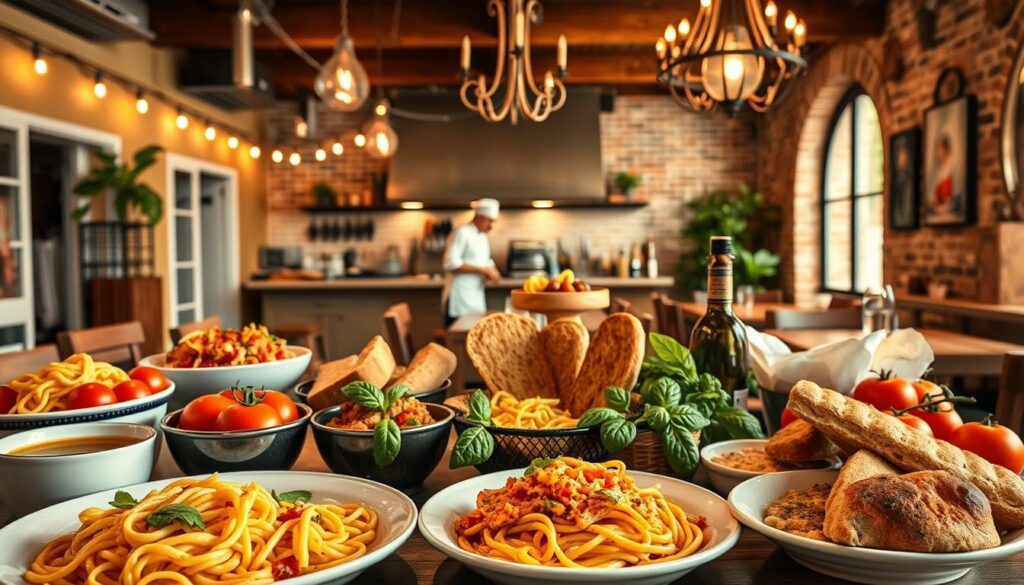
The Importance of Fresh Ingredients
Fresh ingredients play a pivotal role in Italian cooking, directly influencing the authenticity and flavor of your favorite dishes. The use of high-quality ingredients not only enhances taste but also ensures that each component shines in authentic Italian food. When you source local produce, you discover a treasure trove of flavor that elevates traditional Italian recipes to new heights.
Sourcing Local Produce
Exploring local markets allows you to select the freshest ingredients at their peak ripeness. Restaurants like Serafina prioritize sourcing local produce, ensuring that you enjoy dishes crafted with the best seasonal choices. From vibrant tomatoes, which add a sweet and tangy kick, to aromatic basil used in sauces like pesto, these ingredients become the foundation of delightful Italian meals. When you embrace the practice of choosing fresh ingredients, you contribute to local farming communities while enjoying superior flavors.
How Quality Affects Flavor
The impact of ingredient quality on flavor is significant. High-quality olive oil is essential, as it enriches Italian dishes with depth and complexity. Similarly, the unique taste of fresh garlic enhances many recipes, offering inviting aromas from the moment you begin cooking. Fresh cheeses such as mozzarella and Parmesan bring distinct textures and tastes, turning simple dishes into memorable experiences. By focusing on these fresh ingredients, you ascend from cooking ordinary meals to creating exquisite Italian culinary masterpieces that delight your palate.
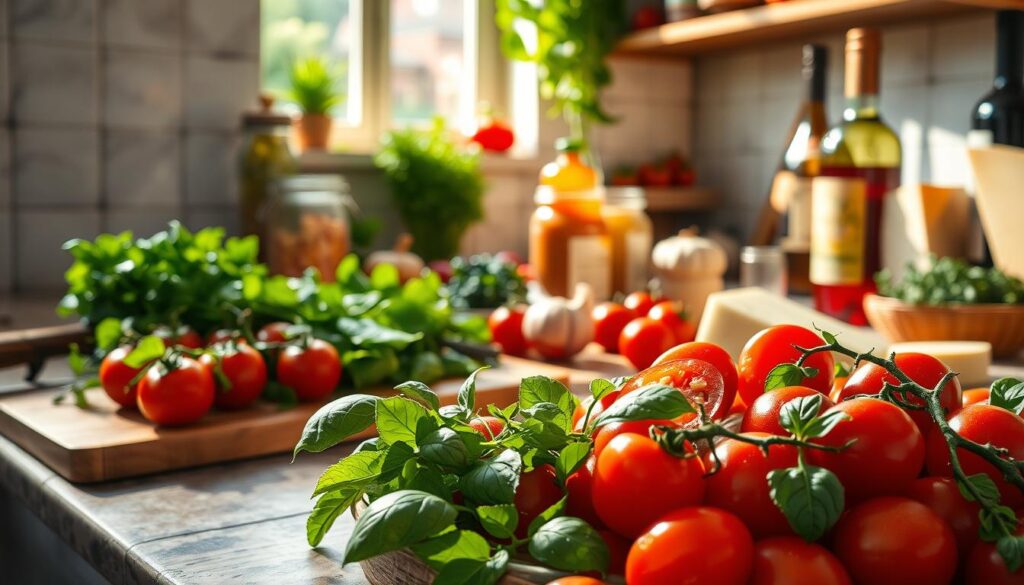
Classic Italian Dishes You Must Try
Exploring classic Italian dishes reveals a treasure trove of flavors and traditions. Authentic pizza and traditional pasta recipes showcase the heart and soul of Italian cuisine, offering experiences that tantalize your taste buds. Many of these dishes have deep historical roots and reflect the regional diversity found throughout Italy.
Traditional Pasta Recipes
Italian pasta dishes are among the most beloved across the globe. Dishes like spaghetti al pomodoro highlight the beauty of simple ingredients—Roma tomatoes, garlic, and fresh basil come together to create a delightful meal that can be prepared in just ten minutes. For a more indulgent option, lasagna layers rich meat sauce, creamy béchamel, and pasta, offering a comforting and hearty option for any occasion.
Don’t miss cacio e pepe, a classic Roman dish, which relies on just three ingredients: pasta, cheese, and pepper. Mastering its preparation is essential for any pasta lover. The careful cooking of the pasta enhances the absorption of flavors from the sauce, resulting in a dish that is both simple and yet incredibly satisfying.
Authentic Pizza Varieties
When it comes to authentic pizza, Pizza Napoletana stands out for its commitment to tradition. To qualify, it must adhere to specific international regulations, including a diameter of at least 10 inches and a raised edge width that allows for that perfect crust. The dough ferments meticulously and is cooked in a wood-fired oven at extremely high temperatures, yielding that characteristic fluffy yet crisp texture.
Traditional toppings include San Marzano tomatoes and buffalo mozzarella, which bring richness to each bite. As you dive into these classic Italian dishes, the history and methodology behind them enrich your dining experience, making every meal a celebration of Italy’s culinary genius.
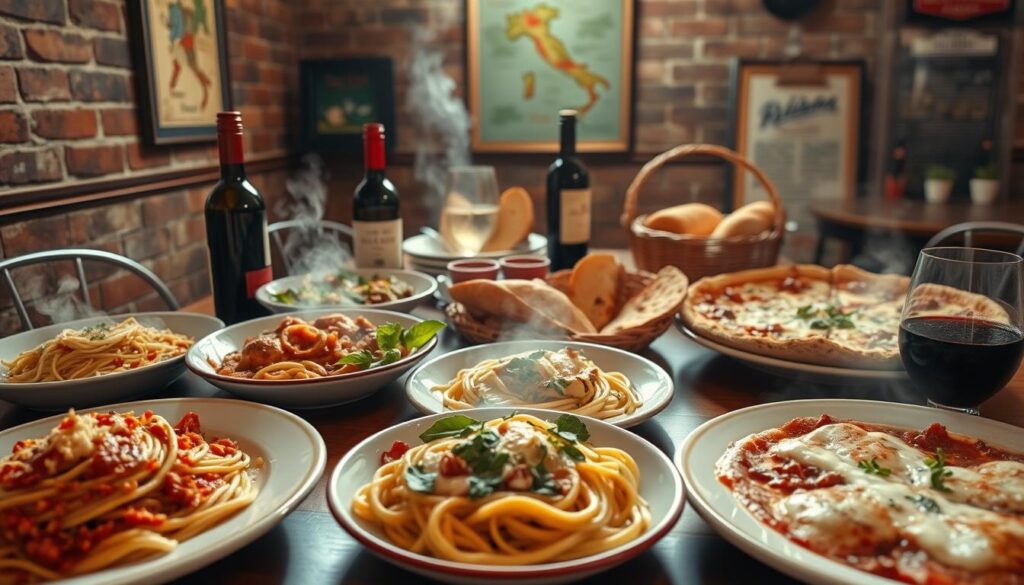
The Art of Making Pasta from Scratch
Creating fresh pasta at home is a rewarding experience that embodies the essence of authentic Italian food. There is a variety of types of fresh pasta, each featuring unique textures and flavors. You can learn about hand-made pasta during specialized cooking classes that include demonstrations and tastings, enhancing your culinary skills and appreciation for Italian cuisine.
Types of Fresh Pasta
- Pappardelle: A wide ribbon-like pasta, it pairs beautifully with hearty sauces.
- Ravioloni: A larger version of the classic ravioli, typically enjoyed during festive occasions.
- Tagliatelle: Originating from Emilia-Romagna, this hand-cut pasta is often served with Ragù or mushrooms.
- Pici: A thick, hand-rolled noodle from Siena that showcases rich sauces, embodying the Cucina Povera tradition.
- Lasagna: One of the oldest pasta forms, its origins spark debate among Naples, Bologna, and Rome.
- Orecchiette: Meaning “little ears,” this pasta is traditionally served with cime di rapa, highlighting its distinctive shape.
Essential Tools and Techniques
To master the art of fresh pasta making, some essential tools and techniques are crucial. A pasta machine allows you to adjust the thickness of the dough, essential for achieving the perfect texture. The general ratio for fresh pasta consists of 1 egg to 100g of flour. Kneading the dough for at least 10 minutes enhances its elasticity, while a resting time of 30 minutes allows it to relax before rolling. Cooking time for tagliatelle is about 2 minutes in boiling water, making it a quick yet delicious option for dinner.
| Pasta Type | Origin | Cooking Time |
|---|---|---|
| Pappardelle | Tuscany | 3-5 minutes |
| Ravioloni | Various regions | 4-6 minutes |
| Tagliatelle | Emilia-Romagna | 2 minutes |
| Pici | Siena | 4-6 minutes |
| Lasagna | Contested | 30-40 minutes (baked) |
| Orecchiette | Puglia | 10-12 minutes |
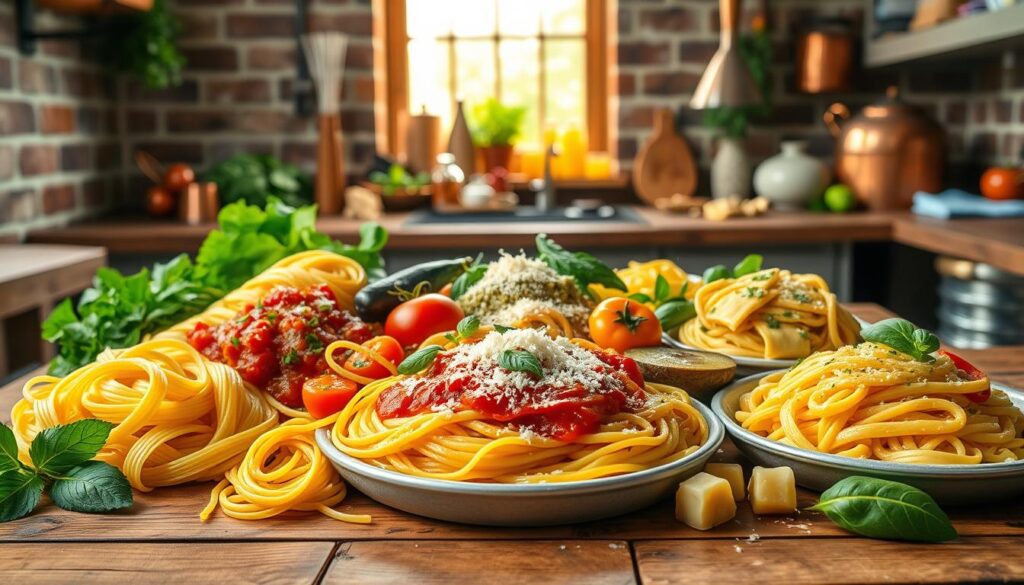
Exploring Italian Regional Specialties
Italian cuisine presents a delightful tapestry of flavors and ingredients that vary significantly from one region to another. Understanding these regional variations enhances your culinary experience, as regional specialties provide a glimpse into the diverse traditions across Italy. Each region combines unique local ingredients, resulting in a rich variety of italian recipes. Here’s a closer look at what Northern and Southern Italian flavors bring to the table.
Northern Italian Flavors
Northern Italy is renowned for hearty dishes that often emphasize butter, rice, and other rich ingredients. Signature items include:
- Risotto alla Milanese from Lombardy, often served with osso buco.
- Piedmont is famous for prized white truffles and Barolo wines.
- Emilia-Romagna, considered Italy’s food valley, is the birthplace of Ragù alla Bolognese and home to Parmigiano-Reggiano and balsamic vinegar.
- Veneto offers unique dishes like Risi e Bisi and Sarde in Saor, reflecting its historical trade routes.
- In Liguria, seafood dishes and pesto are popular, utilizing local fresh catch and flavorful herbs.
The northern approach to cooking generally uses less olive oil, favoring butter and various dairy elements, showcasing a distinct shift from the southern traditions.
Southern Italian Influences
In contrast, Southern Italian cuisine highlights fresh ingredients, including a plethora of vegetables, legumes, and olive oil. Noteworthy dishes include:
- Pizza Margherita from Campania, famed worldwide for its simplicity and quality.
- Campania is also known for its Mozzarella di Bufala and a variety of seafood dishes.
- In Lazio, robust pasta dishes like Carbonara, Amatriciana, and Cacio e Pepe feature prominently.
- Puglia emphasizes traditional meals like Orecchiette con Cime di Rapa, highlighting legumes and olive oil.
- Sicilian cuisine showcases its rich history with dishes like Caponata and Arancini, reflecting Arab and Greek influences.
The diverse culinary traditions across Italy are a testament to the country’s regional variations. Exploring these specialties allows you to appreciate the depth and richness of italian cuisine.

Italian Appetizers You Can’t Miss
Italian appetizers, known as antipasti, play a vital role in the culinary landscape of authentic Italian food. These small plates set the stage for a memorable meal, rich in flavor and variety. Engaging your guests with a fantastic spread of antipasto can enhance any gathering. Here are some essentials and creative ideas for appetizers that will impress every palate.
Antipasto Platter Essentials
An antipasto platter filled with delightful treats is a celebrated aspect of Italian dining. A well-crafted platter should include:
- Cured meats: Consider prosciutto, salami, and capicola.
- Cheeses: Select a range from fresh mozzarella to sharp gorgonzola.
- Olives: Varieties like Kalamata and Castelvetrano add depth.
- Vegetables: Marinated artichokes and roasted red peppers bring color.
- Pickled elements: Peppers and vegetables elevate the flavor profile.
Most of these items require minimal preparation time, making them perfect for spontaneous gatherings, often ready in just 15 to 30 minutes. You can adapt many recipes to cater to vegetarian preferences, ensuring every guest finds something to enjoy.
Popular Crostini Ideas
Crostini make for versatile and stylish appetizers. Their crispy base allows for endless topping possibilities. Some delightful combinations include:
- Ricotta and honey: A sweet and savory twist.
- Mushroom tapenade: Earthy flavors packed with umami.
- Fava beans with Pecorino: Fresh spring flavors for a vibrant bite.
- Bruschetta with summer tomatoes: A classic that highlights seasonal freshness.
- Spinach-artichoke spread: Creamy indulgence that everyone loves.
These crostini options require little cooking and are often ready in under 20 minutes, making them ideal choices for anyone seeking practical cooking tips. Emphasizing local ingredients not only enhances the taste but also supports community farmers.
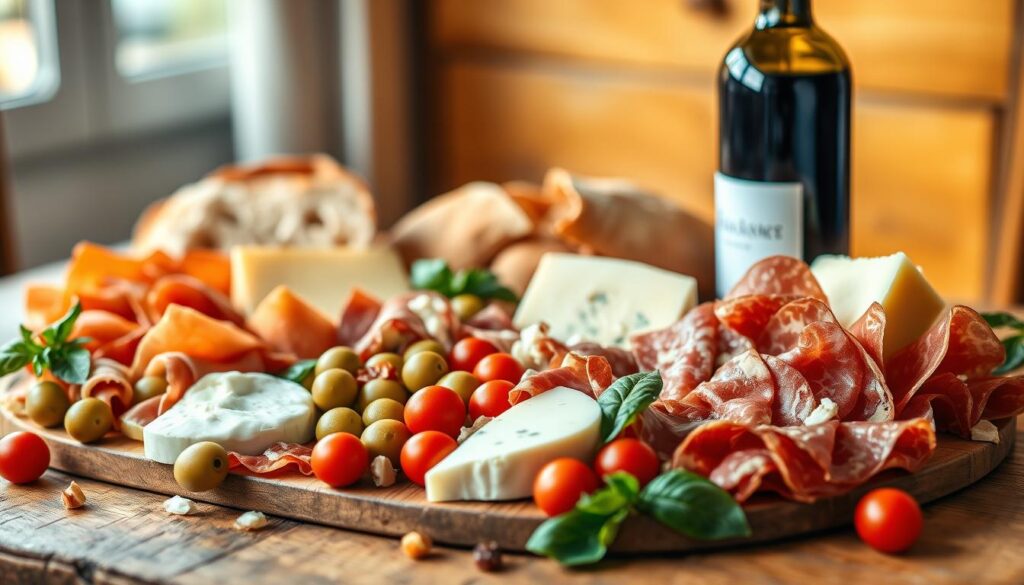
| Appetizer | Preparation Time | Serving Size | Calories per Serving |
|---|---|---|---|
| Antipasto Platter | 15-30 minutes | 16 servings | Approx. 116 |
| Crostini with Ricotta | 10-20 minutes | 12 servings | 80 |
| Bruschetta | 15-25 minutes | 10 servings | 50 |
| Classic Caprese Salad | 10 minutes | 4 servings | 100 |
| Spinach-Artichoke Dip | 20-30 minutes | 8 servings | 200 |
Embrace the richness of authentic Italian food by exploring and personalizing your own appetizer offerings. Each creation not only tantalizes the taste buds but also fosters a genuine connection to Italy’s culinary traditions.
Savoring Italian Sauces
Italian sauces play a crucial role in highlighting the rich flavors of authentic Italian food. From marinara to pesto, each sauce brings its own unique character to a variety of dishes, making them essential for anyone looking to dive deeper into Italian cooking. Understanding these sauces can elevate your marinara recipes and other culinary creations.
Marinara and Pesto Recipes
Marinara sauce stands as a timeless staple in Italian cuisine. Made from ripe tomatoes, garlic, and a blend of herbs like basil and oregano, this uncomplicated sauce is both versatile and satisfying. You can use it to enhance pastas, pizzas, or even as a dipping sauce for breadsticks.
Pesto, originating from the Liguria region, offers a vibrant contrast to marinara. This sauce combines fresh basil, garlic, pine nuts, and olive oil into a fragrant and flavorful paste. Serve it over pasta, mix it into salads, or spread it on sandwiches for an inspiring twist on your favorite meals.
The Perfect White Sauce
When exploring Italian sauces, a creamy white sauce deserves mention. Often referred to as béchamel, this sauce is made from butter, flour, and milk, creating a rich base that complements various dishes. Use it in lasagna or as a creamy topping for vegetables to unlock the door to more indulgent interpretations of authentic Italian food.
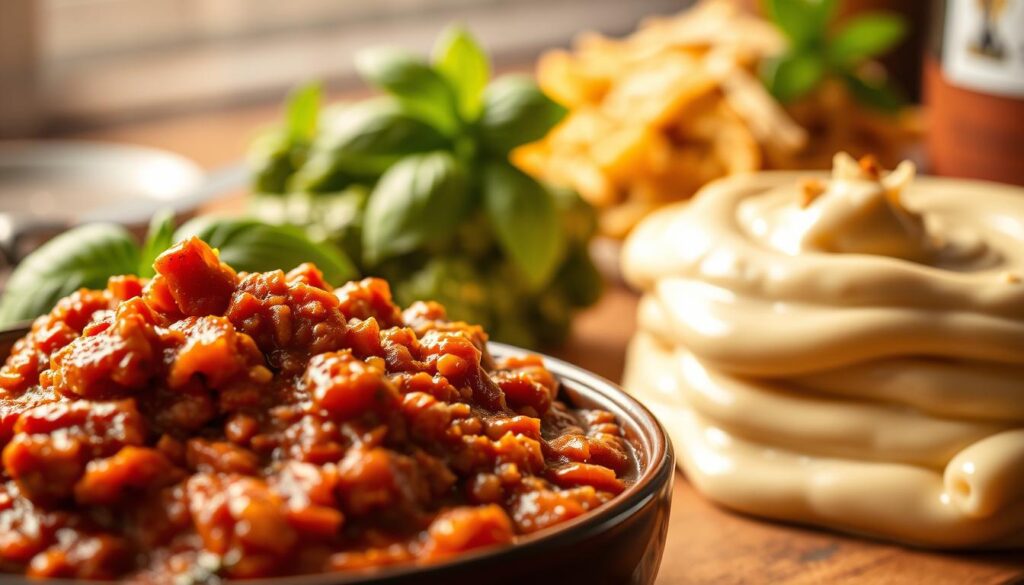
Italian Desserts to Satisfy Your Sweet Tooth
When you think of authentic Italian food, desserts play an essential role in completing the dining experience. The rich heritage of italian desserts showcases various flavors and textures, captivating the taste buds of many. Among these delights, tiramisu and cannoli stand out as must-try options, offering something for every sweet tooth.
Tiramisu: A Creamy Delight
Tiramisu, which means “pick me up,” is a classic favorite that features layers of coffee-soaked ladyfingers and rich mascarpone cheese. This dessert captures the essence of italian desserts by combining the love of coffee with sweet indulgence. Available in the best italian restaurants, this creamy delight often tops dessert orders, accounting for approximately 25% of all dessert selections. Whether you enjoy it at a local café or an upscale dining venue, this dessert never fails to impress.
Cannoli: A Crispy Treat
Cannoli represent another pillar of italian desserts. The crispy shells filled with sweet ricotta, powdered sugar, and vanilla make for a simple yet delicious treat. In Sicilian restaurants, cannoli are often chosen by about 50% of diners as their dessert of choice, a testament to their popularity. You can find variations of this beloved dessert in many best italian restaurants, each showcasing their unique spin on an age-old recipe.

The Italian Coffee Experience
Coffee is deeply woven into the fabric of Italian dining culture, presenting a unique narrative of tradition and artistry. The Italian coffee experience hinges primarily on *espresso*, a beverage celebrated for its intense flavor and versatile use in various drinks. Throughout the country, you’ll find a vibrant coffee culture where each region might offer its own specialties, frequently enjoyed while standing at a bustling café bar. Savoring the rich flavors of these authentic italian coffee drinks should be an integral part of your exploration of italian cuisine.

Espresso and Its Variations
Espresso stands as the heart of Italian coffee. Its roots trace back to the 16th century, forever changing how coffee is consumed. Iconic *espresso variations* include:
- Caffè Macchiato: A shot of espresso marked with a small amount of steamed milk.
- Cappuccino: A popular choice consisting of equal parts espresso, steamed milk, and milk foam.
- Caffè Latte: A creamy blend of espresso and steamed milk.
- Ristretto: A concentrated shot of coffee made with less water.
- Affogato: A delightful mix of hot espresso poured over a scoop of vanilla gelato or ice cream.
- Mocha: A coffee drink that melds espresso with chocolate and steamed milk, often topped with whipped cream.
Popular Italian Coffee Drinks
Beyond espresso, the menu at Italian coffee bars showcases enticing variations that reflect regional preferences and preparation methods. Common italian coffee drinks include:
- Caffè Corretto: Espresso “corrected” with a splash of liquor, typically grappa or Sambuca.
- Caffè Doppio: A double shot of espresso for those in need of an extra kick.
- Shakerato: Iced espresso shaken with sugar for a refreshing treat.
Enjoying these drinks not only satisfies your palate but also immerses you in the communal essence of Italian life. Coffee drinking rituals, ranging from the quick espresso to relaxing moments with a cappuccino, reveal a world of camaraderie and vibrant culture. As you relish each sip of these exquisite italian coffee drinks, remember that you’re partaking in a tradition that has spanned centuries.
Pairing Italian Cuisine with Wine
Exploring the world of wine pairing can elevate your experience with authentic Italian food. Italy boasts around 20 different regions, each with its unique wines that beautifully enhance its diverse cuisine. Knowledge of these italian wine regions can turn a satisfying meal into a memorable gastronomic journey.
Italian Wine Regions to Explore
Among the most renowned regions, Tuscany is celebrated for its Chianti, a versatile wine perfect for pairing with tomato-based sauces. Piedmont, on the other hand, is famous for Barolo, a wine reserved for special occasions, sought after by many households across the nation. Here’s a glimpse into some remarkable pairings:
| Dish | Recommended Wine | Notes |
|---|---|---|
| Fresh Handmade Pasta | Sangiovese | Its slight sweetness complements the dish. |
| Seafood Dishes | Vernaccia | This light white wine shines in summer meals. |
| Pasta with Mushrooms | Dolcetto | Fragrant profile pairs beautifully with earthy flavors. |
| Grilled Salmon | Pinot Noir | Chilled, with fruity notes enhances the fish. |
| Chicken Parmesan | Pinot Grigio | Bright acidity contrasts the dish’s richness. |
| Seafood Risotto | Verdicchio | Notes of crisp apple and pear elevate the meal. |
| Goat Cheese Appetizer | Sauvignon Blanc | Hints of pepper spice and oak bring balance. |
| Pasta with Tomatoes | Prosecco or Lambrusco | Sparkling wines enhance vibrant flavors. |
Food and Wine Matching Tips
Understanding wine pairing improves your dining experience. For instance, pairing Chianti with red sauces works well due to the wine’s acidity. Likewise, Chardonnay complements oil and cream-based sauces brilliantly, making it versatile for Italian cuisine. To make the most of your authentic Italian meals, try these tips:
- Match the weight of the dish with the weight of the wine.
- Consider the primary flavors; for herb-forward dishes, Sauvignon Blanc is an excellent choice.
- Don’t overlook regional pairings. Wines from the same region as the food often enhance the overall taste.
- Experiment with contrast; a dish rich in protein may pair excellently with a zesty white wine.

Celebrating Italian Food Culture
Italian food culture is more than just the meals served at the table. It is a celebration of life, togetherness, and the rich traditions that have shaped culinary practices for generations. Central to this culture are family meals, where loved ones gather to share multiple courses, creating bonds that go beyond the dining experience. The emphasis on communal dining highlights the importance of family in the Italian lifestyle. In Italy, meals are cherished moments that can last for hours, creating lasting memories.
The Role of Family Meals
Family meals play a crucial role in Italian food culture, often marking important events and daily connections. On Sundays, households prepare a feast that includes various courses, showcasing favorite traditional recipes. Approximately 80% of Italian meals involve a communal aspect, reflecting the cultural importance of sharing food. Italians value their time together, often cooking dishes that have been passed down through generations, like rich pasta dishes and hearty roasts.
Food Festivals and Events in Italy
Food festivals are vibrant expressions of italian food culture, held across the country to celebrate local ingredients and culinary heritage. In 2022 alone, Italy hosted over 1,500 food festivals, featuring everything from seafood traditions at the Sagra del Pesce in Camogli to grape harvest celebrations. These events encourage exploration of regional specialties, making them a delightful way to experience the flavors and stories tied to each dish. Whether you’re sampling artisanal cheeses or fresh pasta, the joy of discovering local culinary treasures is a reflection of Italy’s rich food traditions.

| Festival Name | Location | Focus | Visitor Count |
|---|---|---|---|
| Sagra del Pesce | Camogli | Local seafood traditions | 20,000+ |
| Festa della Repubblica | Nationwide | Traditional dishes | Varies |
| Grape Harvest Festivals | Various regions | Wine tasting and feasting | Varies |
| Pizza Festivals | Various locations | Celebration of pizza | Varies |
Cooking Italian at Home
Cooking Italian at home can truly transform your culinary experiences. Mastering essential techniques enhances your ability to create authentic Italian food right in your kitchen. By concentrating on simple, fresh ingredients, you can develop a strong foundation in italian recipes, leading to countless delicious meals. Getting hands-on with these methods allows you to appreciate the beauty of each ingredient, as well as the joy of creating something uniquely yours.
Essential Cooking Techniques
To excel in cooking Italian, focus on fundamental methods that define the cuisine. Creating a classic pasta dish, such as aglio e olio, teaches valuable skills in pasta-saucing that you can apply to various recipes. Other important techniques include:
- Making sauces, like the revered Bolognese ragù
- Creating fresh pasta from scratch
- Utilizing seasonal produce for optimal flavor
- Perfecting the art of risotto through constant stirring for creaminess
These techniques highlight the essence of authentic Italian food, enhancing both the flavors and textures of your dishes.
Must-Have Italian Cookbooks
Investing in quality cookbooks can be your guide to mastering cooking Italian. Look for titles from renowned authors like Marcella Hazan or Lidia Bastianich, who offer authentic approaches and practical tips. Consider these essential cookbooks:
- Essentials of Classic Italian Cooking by Marcella Hazan
- Lidia’s Italy in America by Lidia Bastianich
- The Silver Spoon, a comprehensive guide to Italian recipes
Each of these cookbooks comes equipped with a variety of italian recipes, encompassing everything from appetizers to desserts, ensuring you can explore the full range of this beloved cuisine.

The Influence of Italian Cuisine in America
Italian cuisine has become a beloved part of America’s culinary identity, deeply rooted in the history of Italian immigration. The late 19th and early 20th centuries saw many Italians settling in cities like New York, Boston, and Chicago. This influx led to the creation of vibrant Italian neighborhoods, bringing an array of dishes and flavors to American palates. Today, numerous American-Italian dishes have emerged, showcasing how these culinary traditions have adapted over the decades and influenced dining culture throughout the United States.
American-Italian Dishes to Know
Familiarity with key American-Italian dishes enhances your dining experiences. These dishes reflect the integration of traditional Italian cuisine with local ingredients and tastes. Iconic favorites include:
- Spaghetti and Meatballs
- New York-style Pizza
- Philly Cheesesteak
- Muffuletta Sandwich
- Chicago-style Deep Dish Pizza
- Toasted Ravioli
- Cioppino
Italian restaurants have played a significant role in popularizing these dishes. As you explore the best Italian restaurants in your area, consider trying some of these classic American adaptations that highlight the rich Italian cuisine history woven into the fabric of American culture.
Popular Italian Restaurants in the U.S.
Throughout the years, Italian restaurants have flourished in American cities. Some establishments stand out due to their long-standing traditions and authentic dishes. Here are a few notable mentions:
- Bamonte’s in Brooklyn, established in 1900
- Marzetti Italian Restaurant in Columbus, opened in 1896
- Original Joe’s in San Francisco, famous for its cioppino
Each of these restaurants symbolizes the enduring relationship between Italian cuisine and American dining, showcasing how flavors, techniques, and culinary traditions continue to evolve. Whether indulging in a plate of spaghetti or a slice of pizza, you are partaking in a rich Italian cuisine history shaped by generations of immigrants.

Vegetarian and Vegan Italian Options
Italian cuisine excels in offering a variety of vegetarian Italian dishes and innovative vegan options. This adaptability stems from the country’s renowned ability to highlight fresh produce and seasonal ingredients. When you savor authentic Italian food, you’ll discover numerous ways to enjoy plant-based flavors that cater to dietary choices without sacrificing taste.
Plant-Based Pasta Dishes
Pasta can be a delightful centerpiece in vegetarian meals. Whether you prefer traditional formats or creative spins, the versatility is endless:
- Pasta alla Norma: Eggplant pasta that takes about 30 minutes to prepare, showcasing this beloved vegetable in a rich tomato sauce.
- Vegan Carbonara: This dish, ready in roughly 15 minutes, swaps bacon for a plant-based alternative while maintaining the classic flavors.
- Penne Arrabbiata: An easy dish with a fiery tomato sauce, a large portion contains around 566 kcal, making it a satisfying vegetarian choice.
- Farinata: A chickpea flour dish that takes about 20 minutes to cook, perfect for a light yet filling option.
Creative Vegan Pizzas
Vegan pizza is another area where creativity shines. You can enjoy various toppings and pizza styles that rival traditional options:
- Mushroom and Spinach Pizza: Using vegan cheese, you can create a decadent topping combination.
- Margherita with Vegan Ricotta: Made with just three ingredients, this homemade vegan ricotta complements the classic flavors of tomato and basil beautifully.
- Yellow Pepper and Artichoke Pizza: A vibrant choice that can easily impress, bringing a taste of Rome right to your table.

By exploring vegetarian and vegan adaptations of traditional recipes, you revel in authentic Italian food while honoring dietary preferences. Let seasonal ingredients and vibrant flavors guide you as you craft satisfying meals that resonate with both taste and tradition.
A Guide to Italian Cheeses
Italian cheeses are a cornerstone of authentic Italian food, enhancing flavors and enriching various dishes. With over 400 unique types of italian cheeses produced across the country, each cheese brings its own distinct character to the table. Whether you’re grating Parmigiano-Reggiano over pasta or savoring the creaminess of Mozzarella di Bufala, understanding the different varieties and their uses can elevate your culinary experience.
Types of Cheeses You Should Try
To explore some of the best Italian cheeses, you must consider classics like Gorgonzola, which comes in two styles: dolce (sweet) and naturale (aged). The aged version is particularly intense, while the dolce version is creamy and mild. Another favorite is Pecorino Toscano, rich in flavor due to its high butterfat content, and available in both fresh and aged forms. Don’t forget Taleggio, which has a gooey texture when warmed, making it perfect for melting over dishes. Each of these cheeses has unique aging processes that affect flavor, making them essential in your kitchen.
How to Incorporate Cheese into Dishes
Incorporating italian cheeses into your cooking can transform an ordinary meal into something extraordinary. Try using grated Parmigiano-Reggiano in risottos, where its savory notes elevate the dish. For a fresh touch, add Mozzarella di Bufala to salads, enjoying its delicate creaminess. Gorgonzola lends itself well in dressings or as a topping for pizzas. Experimenting with these cheeses in your favorite recipes can result in a delightful exploration of flavors, making any meal feel like a true taste of Italy.
